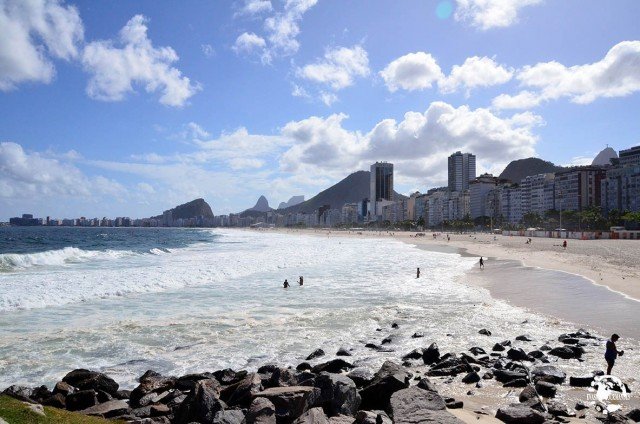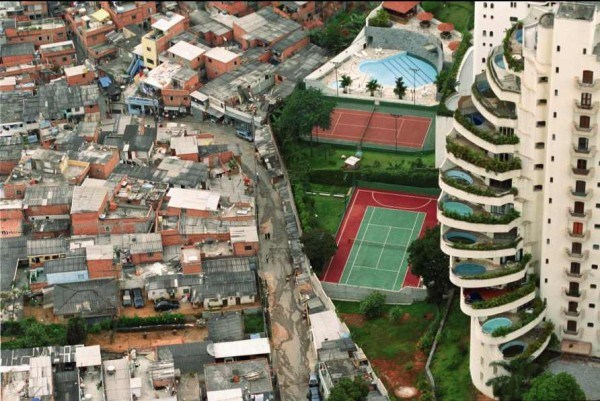I will take you to one of the most beautiful cities in the world: Rio de Janeiro. With its dream beaches, its historical center, its colorful culture, Rio is a city to discover at least once in your life but be careful, we quickly become addicted to it.
It is not for nothing that she is nicknamed the "Cidade Maravilhosa". Rio de Janeiro is a unique city that makes you dream and when you discover it for the first time, you can only be impressed by the richness it has to offer. I literally fell in love with her.
Rio de Janeiro is a city of colors and contrasts where festive ambiance, mythical beaches, lush forests, mountains, colonial architecture and imposing favelas mix all together. If you haven't seen it yet, I invite you to watch our video of Brazil in 3 minutes.
The warmth of the sun, the smiles and the hospitality of the Brazilians make Rio a unique place where you feel so good that you never want to leave.

Come with me, I will take you to discover this incredible city!
Welcome to rio de janeiro, the cidade maravilhosa
Rio de janeiro and its beaches
From Copacabana to Grumari via Ipanema, São Conrado (very chic district) or Recreio, beaches in Rio de Janeiro, there is something for everyone out there.
Copacabana and Ipanema are mythical, there is a special and very friendly atmosphere. People walk along the beach on the black and white paved path. It's very pleasant.
Along the way, we meet sportsmen and women who have come to do their jogging or weight training, sellers of pareos, football jerseys, jewelry (and even umbrellas), small stands of pancakes of tapiocas (it's absolutely delicious to taste) or churros, small restaurants which are very expensive.
I walked miles to Leblon or Leme
To observe a nice panorama of Copacabana, take a short tour of the fort (6 R$) after station 6.
Between these two beaches is the Pedra do Arpoador, a large rock with a magnificent view of Ipanema and Leblon, the Morro Dois Irmaos and Pedra da Gavea. Soleily's couchers are gorgeous.
For a little more peace and quiet, you have to drive about 40 minutes away from Copacabana by car, cross Barra de Tijuca, the Miami of Rio with its immense shopping malls and its chic and ultra-secure residences, then stop at Recreio or Grumari.
Grumari is the wild coast of Rio. It is classified as a Municipal Natural Park and has very quiet beaches bordered by small forests. An ideal place to quietly eat on the beach with delicious camarão pasta (shrimp doughnuts) and other dishes at very good prices (much cheaper and better quality than the small restaurants on Copacabana beach)
It is impossible for us to discover Rio without going to Corcovado and admiring the statue of Christ the Redeemer. It is one of the city's emblems and is one of the seven new wonders of the world. Indeed, a true wonder. The view of the bay of Guanabara is breathtaking. It is from here that the beauty and vastness of Rio are truly measured.
There are several ways to access it. We opted for the van at the exit of the Largo de Machado metro station for $41 per person. It takes about 20 minutes to get there. The other option was to take a bus to Cosme Velho and wait for very long minutes (or even hours) for the little red train that crosses the Tijuca forest.
Located in the district of Urca, Pain de Sucre is another treasure of Rio. The entrance fee is 62R$ and you can access it by taking 2 cable cars. The first one makes a stop on the Morro da Urca and it is from here that we take the second one until the Pain de Sucre. The view is incredible: Copacabana on one side, the Corcovado opposite, Botafogo and Flamengo on the right, and Niteroi behind us. A 360° panorama!
The best time to go is in the late afternoon just before sunset. At night, it's even more beautiful.
At the foot of Pain de Sucre is the superb beach Praia Vermelha. From there, you can take a path to the Morro da Urca. On our way, we met many small monkeys always on the lookout for food scraps.
The Selaron Staircase is a work of artist Jorge Selaron, who died in 2013. More than a hundred steps are decorated with tiles of earthenware, coming from many different countries like Thailand, South Africa, France, USA, Kazakhstan, etc. It's very impressive.
It is located between Lapa and Santa Teresa.
Whether you're a football fan or not, visiting the famous Maracanã is a must when visiting Rio de Janeiro for the first time.
Pele, Bebeto, Romario, Ronaldo and many other world-famous days have tread this legendary pitch.
Did you know why the stadium was called Maracanã? It's actually the name of a species of birds that lived there when it was still wild!
A very pleasant visit, since you can enter the locker room where players' jerseys are hung, approach the lawn, sit in the bleachers, play commentator. No need to take a guide for the visit.
Price: 16R$
From Copacabana, take the orange metro line to Estacio, then the green line to Maracanã station.
Rio de janeiro, the savage
Want to cut with the city? Let that not hold. The city is full of places to change the atmosphere and meet in a few minutes in another setting. I will quote a few of them, to be done absolutely.
The Tijuca Forest, the world's largest urban forest. It is located in the heart of the city.
For hiking fans, the ascent of Morro Dois Irmaos offers an extraordinary view of the city. The departure is in the Vidigal favela, and there is about 1.5 hours walk to the summit from where you can admire an extraordinary view of the city.
Another place to admire the view of the city is the Vista Chinesa. It is a pagoda overlooking the city, further south, with a panoramic view of Lagoa and Ipanema.
To organize these hikes, contact my friends Gilles and Thierry from de RIO FRANCE EXPRESS, located in Rio. They will offer you a wide choice of visits, accommodation and other services and will meet your expectations.
The Jardim Botanico, in the area of the same name, is a quiet and serene place yet situated in the city close to roads and houses. The park is huge and really beautiful. There are many species of plants, trees, orchids and with a bit of luck, you can see toucans, squirrels, and monkeys.
Lake Rodrigo de Freitas was a real favorite, not for the beauty of the landscape with the mountains in the background but for the atmosphere, especially on Saturday afternoon. Families and friends get together to celebrate a birthday around well-organized picnics, to go for walks in Rosalie or by bike. Ideal place to sip a sucos de maracuja!
Santa teresa, lapa, and centro
Here are three other districts of Rio to visit. A minimum of one full day is required.
The historic center is home to superb monuments such as the Municipal Theatre or the Cultural Centre of the Banco do Brasil, beautiful churches and large squares such as Praça XV or Tiradentes. Do not miss the popular market of Uruguaiana to find yourself in the atmosphere of the Cariocas. I'll tell you later about a neighborhood little known to tourists: Morro da Concecao
Lapa is party district with its many bars and restaurants. It is located just behind the Arcos de Lapa, from where the tramway left for Santa Teresa, now at a stop following the dramatic incident of 2011.
Santa Teresa is the bohemian quarter. Another crush, by the way. Artists' galleries, restaurants, improvised bars on the rooftops of houses, there is really a warm and quirky atmosphere that I love.
Rio de janeiro and the favelas
Rio wouldn't be what it is without the favelas. They are an integral part of the city and the landscape.
Exploring a favela is possible today, but 5 years ago it was unthinkable. Some favelas, which Brazilians prefer to call "communities" have been "pacified". In fact, the police are present and provide security. Rocinha is a lively neighborhood. There would be 160,000 inhabitants, impossible to verify since no census has been done so far.
However, I do not recommend that you make your visit alone. For our part, we called on Rafael, a tourist guide and resident of Rocinha, the largest favela in Rio de Janeiro. Rafael is known to all the inhabitants and thanks to him, I was able to learn more about the way of life of the inhabitants and to make nice encounters. This experience remains unforgettable because the welcome was very warm.
Rocinha is a lively neighborhood. There would be 160,000 inhabitants, impossible to verify since no census has been done so far.
To learn more about Rafael and the visit to the favela, I invite you to read my article on the subject "Meeting with Rafael, favela guide".
Advice and practical information
The cost of living: Like all major cities, it is high enough for the country but the prices are pretty good to see low for us.
As far as food is concerned, you can eat well and cheaply in the restaurants by the kilo for 25R$ for example or in the small restaurants-bars that offer you the famous quejos with cheese, coxinhas, camarao pasteis at 6 or 7 R$. In supermarkets, it's still cheaper than in France. Avoid the restaurants on the beach in Copacabana, they are expensive and the quality is good.
In terms of accommodation, it will cost you a lot more if you stay in hotels in Copacabana or Ipanema, little in guesthouse or youth hostel and obviously nothing in Couchsurfing.
Rio remains a very accessible city, even with a small budget.
Public transportation: The cost of the bus is 2,5R$ and the metro 3,5R$. A free bus is set up in Copacabana to go to the Rio Sul shopping center.
There are buses to almost everywhere. Actually, there are even too many of them and it's a bit difficult to get by at first. On the beach of Copacabana, there is a small information stand for tourists where you will be given a very practical card with bus numbers for each destination, the price of the taxi etc.
Brazilian Cuisine: Let's say it, in Brazil and more precisely in Rio de Janeiro, we enjoy it. Small stalls, restaurants by the kilo, or restaurants a little more fashionable, don't miss the culinary specialties ultra gourmet such as churrascaria, coxinhas, Pao de queijo and so on. Put your taste buds in appetite with the article on my culinary discoveries in Rio de Janeiro!
Insecurity: I didn't feel it, but I can't say that it isn't there because, in some northern neighborhoods where the favelas aren't pacified, you have to be careful. As everywhere in the world, there are rules to follow like not wearing flashy jewelry, watching your things at the beach, better to go only with your towel, avoid public transport at night and prefer the taxi, ground rules etc.
We walk without problems in the evening and at night in Copacabana and Ipanema and Santa Teresa.
Rio de Janeiro is a destination that you will enjoy and that you would never want to leave again. At the beginning, we were supposed to stay there only 6 days, but we fell under the spell of this city of contrast and finally stayed there for almost 15 days!
So, when are you guys going?
I've always wanted to go to Rio. But word on the street is that you get a lot of this:

Downvoting a post can decrease pending rewards and make it less visible. Common reasons:
Submit